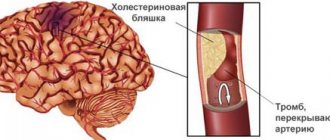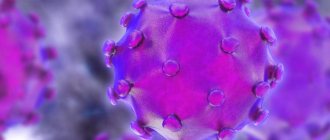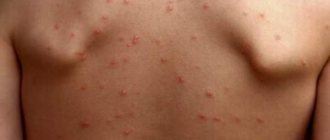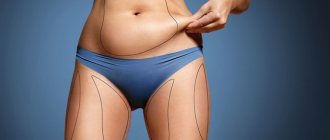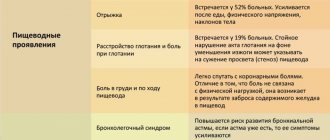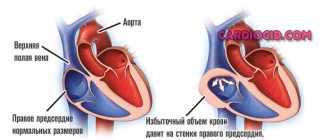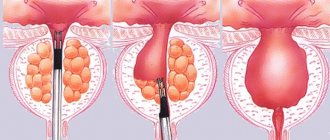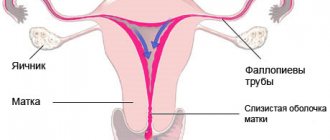Erythrasma is a bacterial skin lesion that manifests itself in areas with large folds: armpits, abdomen, groin area, under the breasts in women, on the inner thigh. Characteristic symptoms of erythrasma are the appearance of gradually growing spots of a reddish, brown and yellowish hue. They are distinguished from other skin diseases by dryness and a tendency to peeling. They are absolutely painless, but require attention because they do not go away on their own. Erythrasma owes its name to Greek terminology - translated into Russian, erythrasma means “colored red.” It is with this that the affected areas glow under the influence of a Wood's fluorescent lamp, with the help of which diagnostics are carried out.
Causes of erythrasma
In the recent past, erythrasma was considered a fungal disease and treatment typical for ailments of this group was prescribed. However, it did not give a guaranteed effect and relapses often occurred. Researchers came to this erroneous opinion because they were confused by the thin whitish threads on the affected areas, which were very reminiscent of the structure of mushroom mycelium. Today, treatment of erythrasma is successfully carried out by dermatologists. In accordance with ICD-10, it belongs to other local skin diseases and is coded as L08.1.
The real cause of unpleasant skin spots is Corynebacterium minutissimum. It constantly lives on the skin of a healthy person, multiplying vigorously and beginning its pathogenic activity only when factors are favorable to it. In their absence, corynebacterium simply lives on the surface of the skin in moderate quantities, without causing inflammation and spots until a certain point. Its environment is only the skin and exclusively the epidermis layer; it does not penetrate deeper. Erythrasma does not appear on nails and hair. The following factors contribute to its activation:
- profuse sweating and a climate conducive to it;
- increased skin moisture for a long time;
- strengthening the alkaline component in the skin pH level;
- diaper rash, abrasions, prolonged dermatitis;
- not regular care: insufficient or excessive use of soap.
The route of spread is exclusively contact - a shared towel, washcloth, public bath, swimming pool, beach, sex. It is very difficult to accurately determine the source - the contact person may not have characteristic spots.
What is dangerous and what complications can it cause?
In severe cases of the disease, the skin is seriously affected, the patient experiences severe weakness, and the body temperature becomes high. If the disease is not treated, there is a possibility of various complications occurring - skin rash, eczema, suppuration, due to a secondary lesion.
The disease is difficult for people suffering from obesity, diabetes mellitus and hyperhidrosis.
What symptoms of erythrasma should I look out for?
Symptoms of erythrasma appear predominantly in adults, obese people with a tendency to excessive sweating. It is very rare in children.
- Individual brown, brownish or yellowish spots are round in shape and up to several centimeters in diameter.
- Large lesions with a smooth surface, pityriasis-like scales and clear boundaries.
- Mild, not constant itching.
- Peeling.
- Getting wet. This does not always occur and depends on the abundance of sweat secretions and the frequency of external moisture.
Unlike other bacterial infections, this disease does not include fever, ulcers, weeping wounds or purulent formations. The spots may disappear and reappear for several years in a row. It all depends on the condition of the skin, climate and immunity in general. Only regular and careful examination of the body will help you notice brownish traces of the activity of Corynebacterium minutissimum in a timely manner.
In men, the inner thighs, navel area, and groin are most often affected (inguinal erythrasma). In women - folds under the breasts, armpits, abdomen. In most cases, the disease manifests itself exclusively as external troubles - just dry reddish or brownish spots.
What is erythrasma
Erythrasma is so called due to the fact that when using fluorescent diagnostics, the lesions glow with a reddish tint. This disease occurs most often in adults, mainly among male patients, and lasts a very long time. In this case, the patient does not experience any negative or painful sensations.
For a long period of time, erythrasma, together with actinomycosis, trichophytosis, pityriasis versicolor, microsporia, favus and epidermophytosis, was considered a skin disease of fungal etiology for the reason that when conducting a microscopic analysis of the scales that were removed from the affected skin lesions, it was possible to detect tortuous thin threads that Outwardly they resemble fungal mycelia. In the current classification, dermatologists believe that erythrasma belongs to the group of pseudomycoses. These diseases, in their clinical picture, are very similar to fungal skin lesions, but they have a completely different etiology.
Types of erythrasma
The following types of erythrasma are found.
- Generalized – due to the pathogen entering the blood, all tissues of the body are affected to varying degrees. In this case, a thorough comprehensive examination and complex, multi-stage treatment are required. Externally, generalized erythrasma manifests itself in the form of many characteristic spots throughout the body and limbs (not only in the folds!). They merge into plaques of a large area. This form is most often found in patients with immunodeficiency.
- Disc-shaped - the spots grow, unite into large round formations up to 10 cm in diameter, become denser, change color to a more saturated one, and can become covered with a light flaky coating. They are found not in folds, but on the surface of the body and limbs. Discoid erythrasma is common in tropical countries, especially in women.
- Interdigital. It manifests itself as peeling of the interdigital space of the feet, less often of the hands. The color of the spots on the limbs is less intense than in the folds of the body - from pale to moderate pink.
- Intertriginous form. This is the name given to corynebacteria affecting large folds of the skin. In men, inguinal erythrasma is most often diagnosed; both sexes are characterized by the intergluteal and axillary form; exclusively in women, it is localized in the inframammary folds, around the navel, and on the abdomen. Seasonal spring-summer exacerbation is typical, when sweating increases as the air temperature increases.
- Vesicular - bullous form - it is characterized by the appearance of vesicles: bullae and vesicles. This type of erythrasma is a consequence of the addition of a secondary infection, an allergy to corynebacteria, and excessive mechanical friction of the tissues affected by it.
Each type of erythrasma has its own treatment, the plan and composition of which also depends on the general condition, the presence of allergies and a history of chronic diseases.
Complications
The main danger of the disease is the risk of complications recorded in patients with hyperhidrosis, diabetes mellitus, obesity and other diseases - the appearance of diaper rash, eczema, vascular disorders, the development of bacterial (streptococcal and staphylococcal) and fungal infections.
Erythrasma in the groin area leads to irritation of the genital organs and the development of secondary infection. The disease is dangerous due to the development of lung abscess, endocarditis, and septicopyemia. The role of Corynebacterium minutissimum in the pathogenesis of male infertility is discussed.
Rice. 9. The photo shows erythematous swelling of the foot in a patient with diabetes mellitus. Multiple blisters and bubbles are visible.
Stages of erythrasma and their characteristic symptoms
In accordance with the characteristic symptoms of erythrasma, the following stages are distinguished.
- Progression. It is characterized by the formation of primary spots, their slow growth, the addition of other symptoms, and secondary infections. Spotting may persist for several months. Progression is expressed both by an increase in the area of the first spot and by the appearance of new ones.
- Stabilization. There is no obvious growth of previously appeared spots and the formation of new ones. At first, slight, not too bothersome peeling is possible. In this condition, the symptoms of erythrasma (dry reddish spots) can persist until the microclimate changes - the ambient temperature, humidity and other factors that provoke sweating decrease. In hot southern climates, spotting can be permanent. In regions with clear seasonal differences in weather conditions, the symptoms of erythrasma “subside” until the next period favorable for corynebacteria.
- Relapse. Available in two versions. The first is seasonal in nature - spots appear annually under the same conditions - in the summer with persistently hot weather. The second is characteristic of prolonged erythrasma, when spots that have already noticeably paled and decreased in size begin to grow again, itching, burning, weeping, and swelling appear.
- Remission. It occurs when the microclimate changes. As soon as the air temperature and humidity decrease, friction of skin areas against each other is eliminated, the inflammation goes away. The color of the affected areas fades, peeling decreases, swelling goes away and the skin condition gradually returns to normal. The duration of remission depends not only on weather conditions and the microclimate of the room, but also on compliance with preventive recommendations.
The earlier it is possible to recognize the symptoms of erythrasma and interpret them correctly, the more effective its treatment and the more sustainable the result.
Symptoms
Let's get acquainted with how exactly this disease manifests itself and develops.
How does the disease progress?
There are several stages in the development of pathology:
- Progression . The number of lesions is slowly increasing, but there are no obvious signs. Mostly last several months.
- Stabilization . An asymptomatic spot appears on the skin, which peels off a little. May continue for a long time.
- Relapse . The disease sharply worsens, causing various characteristic symptoms - itching, burning, swelling, and an increase in the affected area.
- Remission . The inflammatory process slows down, the spots decrease in size, peeling stops, and the lesions acquire an inconspicuous appearance.
The disease is protracted and occurs in a chronic form. Small spots after infection increase in size and peel over time. Most often, the stages of remission and exacerbation in patients alternate.
Without treatment, the duration of the disease can exceed ten years. Relapses are often observed 4-6 months after treatment, due to the onset of heat and increased sweating.
In autumn and winter, the manifestation of infection is minimal. In spring, an increase in air temperature provokes its activation.
Since there are no additional symptoms, people postpone treatment and make an appointment with a specialist only after complications appear - suppuration and diaper rash.
Where is the skin disease most often localized in men and women, photo
In males, rashes are predominantly observed in the groin area, inner thigh, scrotal folds and on the skin around the anus.
In women, the infection usually affects the folds under the mammary glands, the skin in the axilla and the umbilical area. In overweight people, the rash sometimes appears on the stomach.
Characteristics of the rash
The main element of the rash is a spot that has a red-brown or light brown tint, clear contours and large sizes. There is slight peeling on its surface. The spot rises slightly above the skin, and is usually clear in the middle.
In summer, with strong sweating, the spot turns brown. Initially, the spots are isolated, but over time they merge into a single whole. Their size is up to two centimeters in diameter, but over time they grow. Pityriasis-like peeling appears on the surface.
What is the patient complaining about?
The pathology occurs without complications, as a rule, without symptoms and the patient discovers it by chance. It progresses slowly, but does not disappear for a long time.
In addition to pigmentation, patients often do not exhibit other characteristic signs of the disease. Plus, sometimes the affected skin areas are difficult to notice - in women the rash spreads under the breasts, and in men in the groin and around the anus.
When the infection worsens, swelling, itching, and burning occur.
Diagnosis of erythrasma
The diagnosis of “erythrasma” is made based on visual examination, medical history and laboratory tests.
Wood's lamp examination
It is enough for an experienced dermatologist to see dry, slightly flaky yellowish-brown or reddish round spots that are not burdened by other signs of infection. The conclusions can be confirmed by examining the skin using a Wood's Lama.
Under the fluorescent light, the affected areas glow in coral-red shades. This is how crinebacteria colonies appear, secreting a special pigment - coproporphyrin, which glows red under a Wood's lamp.
The procedure is carried out in a dark room after abstaining from water procedures for 1-2 days. Coproporphyrin is washed off with water and is not detected after washing hands and other surfaces.
Laboratory research
They are carried out when there is doubt about the diagnosis after examination under a fluorescent lamp.
- Bacterioscopy. Scraping is done from the affected areas of the skin. Two types of research are carried out with the collected material.
- Staining with methylene blue. Under its influence, corynebacteria appear in the form of rods, similar to curved single-headed pins.
- Potassium hydroxide test. Treatment of scrapings with this chemical eliminates lichen, candidiasis, and dermatophytes.
- Bacteriological culture. It involves sowing scraping materials in a special favorable environment. Colonies of corynebacteria grow slowly - from 7 to 14 days. Due to the length of time it takes to obtain test results, it is rarely used to confirm the diagnosis of erythrasma. Bacterioscopy gives quick results and is therefore more effective.
- Histology. A biopsy of the material taken for research - a small area of inflamed skin - makes it possible to detect and accurately identify colonies of corynebacteria. In most cases, histology is not performed due to the complexity and duration of the study. But, it is indispensable in complex, advanced cases, aggravated by the manifestation of other infectious skin lesions and allergic dermatitis.
Symptoms of erythrasma are similar to those of acanthosis nigricans, seborrheic, contact and allergic dermatitis, diaper rash and candidiasis of the folds, tinea versicolor, confluent papillomatosis, inversion psoriasis, and mycosis. It is possible to make a correct diagnosis and prescribe effective treatment only after all of the above studies.
Treatment of erythrasma
Treatment of erythrasma is carried out simultaneously in several directions - its task is to prevent further infection, eliminate its cause and already manifested symptoms.
Drug therapy
In 2015, the Russian Society of Dermatovenerologists developed and approved Federal clinical guidelines for the treatment of erythrasma. In accordance with them, the patient is prescribed a course of local and complex therapy. These are drugs with antibacterial, antifungal, antiseptic and exfoliating effects.
Local treatment of erythrasma
Local treatment refers to the treatment of erythrasma, aimed at treating only the affected areas of the skin. These are ointments with an antibiotic, to which gram-positive corynebacterium and antiseptics are sensitive.
- Antibacterial ointments. As a rule, they contain erythromycin. You will have to use them and smear the inflamed areas for at least 2 weeks. Under the influence of a properly selected antibiotic, corynebacteria dies. The spots first lose their intense color, decrease in size and gradually disappear.
- Antifungal ointments. These are drugs containing ketoconazole, isoconazole or terbinafine. For severe inflammation, ointments with glucocorticoid are prescribed. The choice of antifungal drugs is justified by the fact that its causative agent in essence, structure and development resembles fungal micelles. It is not for nothing that this diagnosis is called pseudomycosis.
- Antiseptics. Along with antibacterial local therapy, antiseptic treatment is mandatory. It precedes the application of ointment and can be repeated without it to maintain dry skin on the affected areas and prevent secondary infection.
Taking into account the localization of damage, the products should be soft, non-burning and at the same time with high intensity. The ideal option is a solution of Rivanol 0.1%. It does not cause pain, dries well, disinfects and restores the skin, especially with axillary and inguinal erythrasma. Its only drawback is its yellow color, which leaves marks on linen, clothes and skin.
- Exfoliating products. For this purpose, ointments with sulfur, tar, and salicylic alcohol are prescribed. They promote rapid exfoliation of damaged tissue and its renewal. Lotions with Rivanol 0.1% have a high regenerating effect.
IMPORTANT: “Consultation with a physician is required before use”
- Ultraviolet irradiation. Solar and local UV rays gently disinfect the skin and promote its regeneration. It is useful for patients with erythrasma to take sunbathing and physiotherapy with ultraviolet irradiation.
Usually, in cases uncomplicated by infection, the above-described course of local therapy is sufficient to treat erythrasma. In case of multiple skin lesions, especially in the generalized form of the disease, systemic antibacterial therapy is carried out.
Systemic treatment of erythrasma
Systemic means a complex effect on the entire body: oral administration of antibiotics (erythromycin or azithromycin), local antifungal, antibacterial and antiseptic therapy. Plus an antihistamine complex and drugs usually used for exacerbation of chronic diseases in their active phase and to prevent it.
In the chronic course of the disease, patients with excessive sweating are prescribed surgical excision of sweat glands in constantly inflamed areas.
Correctly selected treatment helps to completely get rid of unpleasant spots in 2-4 weeks. The main thing is to strictly follow the doctor’s recommendations.
Recommendations and prevention
The duration of the fight against corynebacteria largely depends on compliance with hygiene rules. It is necessary to maintain not only cleanliness, but also dry skin. The risk of self-infection is very high - particles of the affected epithelium in the form of exfoliated scales settle on underwear, clothes, towels, shoes, etc. At the next contact, they again appear on the skin as a source of new infection. To avoid this, the following recommendations should be strictly followed.
- Clothes, underwear and shoes of a patient with erythrasma must be washed especially carefully at high temperatures with a strong SMS.
- Linen and underwear should be changed daily, and be sure to be ironed before putting on.
- It is advisable to take a shower with antibacterial soap (baths are excluded for now).
- After a shower, dry all skin folds well.
- After the stains disappear, wipe their places with a solution of 0.1% Riivanol for at least a month. It dries and disinfects the skin.
- Refusal of tight clothes and underwear, selection of things strictly according to size with a small margin.
- Preference for natural fabrics that allow air to pass through well.
- Fight sweating with antiperspirants, antiseptics, and deodorants.
Patients with diabetes mellitus, pregnant and lactating women should be especially attentive to the manifestations of erythrasma. The first one needs to constantly monitor blood glucose levels and be under the supervision of an endocrinologist. Pregnant and lactating women need to choose a course of treatment with minimal impact on the fetus and milk composition.
Complications of erythrasma include diaper rash and secondary infections. Patients with diabetes mellitus, immobile people and those suffering from hyperhidrosis are most susceptible to them. Another risk group is those who are too careful about their own hygiene. When washing your body several times a day and constantly using hand sanitizers, the natural protective barrier is disrupted and increased sweating occurs. Our simple recommendations will allow you to avoid its consequences and cure erythrasma once and for all.
Related methods of prevention
- It is advisable to wash underwear every day and iron it thoroughly.
- choose clothes from natural materials (cotton, linen), avoiding wearing synthetics; It is recommended to wash new clothes before putting them on - this makes them softer and improves oxygen access to the skin.
- You need to dress according to the weather. You should not allow the body to overheat, leading to increased sweating.
- Wearing someone else's unwashed clothes should not be allowed.
For people who have already had erythrasma and been treated for it, secondary prevention of this disease should be used, aimed at preventing relapses of the process.
For a month after treatment, daily wipe the skin folds with a 2% solution of salicylic alcohol or 1-2% camphor alcohol, followed by mandatory sprinkling of these areas with talcum powder or baby powder.
This article is posted for educational purposes only and does not constitute scientific material or professional medical advice.
